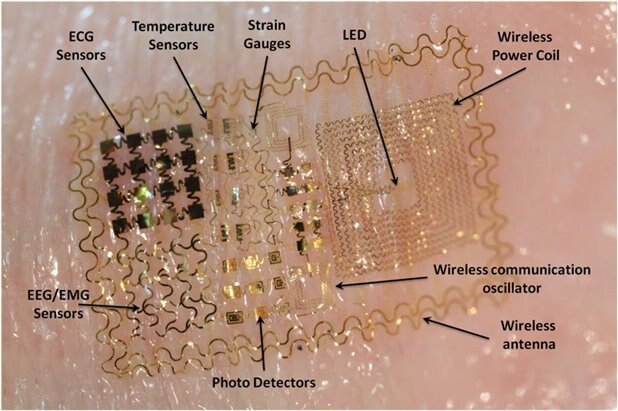"E-tattoo" prototype. Getting closer to reality (cia University of California)
We’ve already discussed about many promising technological leaps in health monitoring by way of miniaturized electronics - brain implant sensors that use optoelectronics to communicate with specific neurons in the brain, stampable circuits that can read blood levels on a patient and transmit information wirelessly. Now, further developments in the realm of flexible electronics come to us from the University of California, San Diego about an “E-tattoo” that can now monitor brain activity as well as standard EEGs.
Todd Coleman, head of the Neural Interaction Lab, alongside several colleagues have worked on brain-machine interface designs for biomedical applications for quite some time now. Their most recent work involves and invisible sticker with hair-sized circuitry that can be applied directly to the skin. By rearranging the electrode locations on the nano-sized electronic tattoo, researchers were able to detect complex brainwaves that were previously inaccessible.
To test their new set-up, volunteers stamped with an E-tattoo on their forehead were asked to pay close attention to a series of images appearing on a screen, taking note when a pre-designated object appeared. Mental focus on a specific stimuli induces P300 brain waves from the forebrain - as volunteers noticed the image, the E-tattoo recorded a P300 signal from the brain as well as standard EEG machines.
The group hopes the work will enable a wide range of medical applications for treating conditions related to neural functioning, the likes of which include Alzheimer’s and depression. By monitoring neural activity, doctors can monitor the patient’s progress, underlying causes, and whether or not medication is doing its job. The team even hopes that one day, such a method of monitoring brain activity could be used to control prosthetic limbs.
For now, focus is on developing a better system for transmitting data wirelessly to a smartphone. This, of course, gives way to an even wider range of possible mobile applications. Coleman’s Lab is also working on developing the technology for unobtrusive pregnancy monitoring in developing countries. Since the technology used in the “E-Tattoo” is already mass-produced, these tiny devices would be made available at an affordable price.
C
See more news at:

